Luxury Travel Review

My visit to awe inspiring Victoria Falls, Zambia
Article and photos by Laura Scheiber
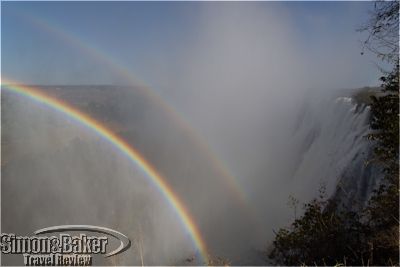
A double rainbow over Victoria Falls
During a trip to Zambia, I visited Victoria Falls, a UNESCO world heritage site forming part of the border of Zambia and Zimbabwe. Powered by the mighty Zambezi River, the falls are over 1,700 meters in width, and an impressive 100 meter drop. The Falls are known in the local language as Mosi-oa-Tunya meaning The Smoke that Thunders. I was in awe at the spray that loomed above this geographic wonder that has bragging rights to the greatest sheet of falling water in the world. One of the Seven Natural Wonders of the World, I anticipated it to be beautiful, but Victoria Falls was beyond my expectations in terms of size, strength and magnificence.
To get to Victoria Falls, I took a one hour flight from Lusaka to Livingstone within Zambia. I stayed at Stanley Safari Lodge, a luxury lodge tucked away on a hillside in the African bush, just a ten minute drive from the falls.

The bridge connecting Zambia and Zimbabwe
To enter Victoria Falls, I had to register at an entry point. International guests at the time of my visit in June 2013 had to pay a fee of $20. Luckily for me, the staff at my lodge arranged day and night walking tours with a private guide, Effeso Hammabola, who helped me navigate through the entry process.
Since I happened to be visiting during a full moon, I had the opportunity to do an evening Luna Tour. The highlight was seeing a rainbow at night, illuminated by the moon above the falls. We stopped at four different viewing points along the man made walkway on the edge of the falls during the hour long tour. I was amazed at how close we could get to the bank of the river just before it spilled over the edge.
Though I enjoyed the evening tour, I much preferred my day visit when I could fully appreciate the beauty and impressive size of the falls.

Effeso Hammabola, my Victoria Falls guide
Thanks to the proximity of my accommodations I was the first guest to arrive and finished up my two hour tour before hoards of tourists entered the site. Starting at the bank of the river, Effeso and I followed the walkway that had numerous lookout points from different angles, including the side of the falls, directly facing the falls and views of the Zimbabwe side where we could see a series of gorges. It was a pleasant pathway with many trees and greenery surrounding it.
I visited at the end of June, which was an ideal time because there was still an impressive amount of water in the Zambezi River that powered the falls yet the water flow wasn’t so strong that the amount of spray made it difficult to see, which happens, I was told, during the wet season.
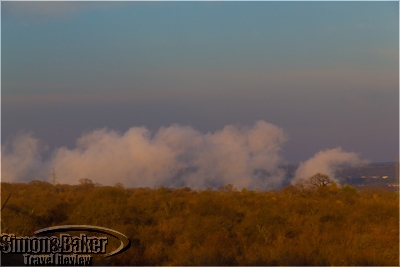
Spray from Victoria Falls
Overall my trip to the area was an unforgettable experience due to the awe inspiring size, incredible force and utter beauty of Victoria Falls. I would recommend a trip to friends and family who are interested in geographic wonders. I also would return to Stanley Safari Lodge to steer clear of the urban hustle and bustle of Livingstone while remaining close enough to the falls in the early morning hours.
Satisfying meals at Portland, Maine eatery
By Elena del Valle
Photos by Gary Cox
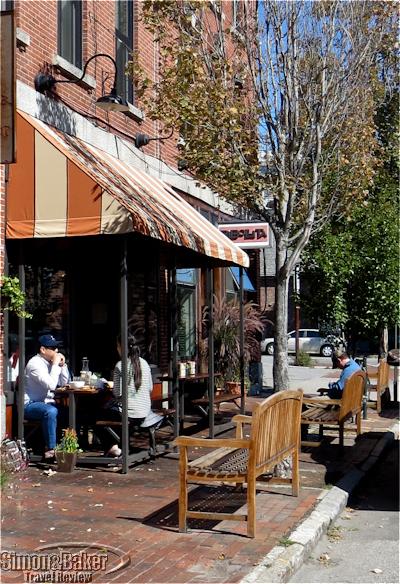
The exterior featured two tables sheltered under an awning
One of our most satisfying eatery experiences in Portland, Maine was at Duckfat. Lunch at the popular informal restaurant was best approached armed with patience and the willingness to share space with neighbors. There were seating options indoors and outdoors. Outdoors there was one wood table with two benches on either side of the entrance door facing the sidewalk and street. The tables were shared by couples and small groups while other would be diners waited on the sidewalk for a place to free up. A staff member explained that a two hour and longer wait was common for lunch.
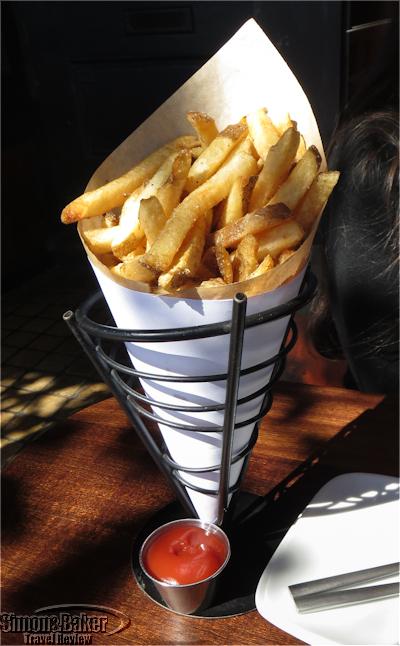
Delicious fries cooked in the namesake oil
The day we dined outdoors, cool temperatures contrasted with the harsh afternoon sunlight that filtered through to our table. Our server was friendly, well informed and helpful. When our Belgian fries, size large, arrived too salty he replaced them quickly. The fries, sandwich and special board of the day followed by an Original Duckfat Milkshake Double Thick with Tahitian Vanilla Bean ice cream shake, a house specialty, were all exceptionally good.
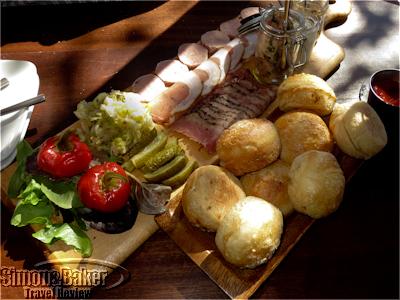
Our first special board of the day
Our next meal, inside the sandwich shop, was less pleasant although the food itself was equally good. Stool seating was possible at stand alone tables or against the wall. It was crowded, warm and noisy. An open kitchen took up the rear of the interior. A narrow hallway led to single stall restrooms shared by the staff.
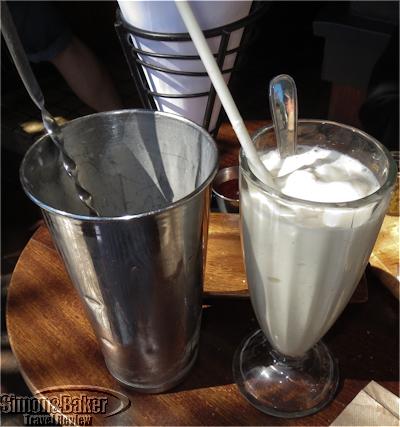
The decadent vanilla bean shake
Our server seemed rushed and left without saying a word halfway through our meal. We had to ask another staff member for a beverage refill, a shake and eventually to pay.
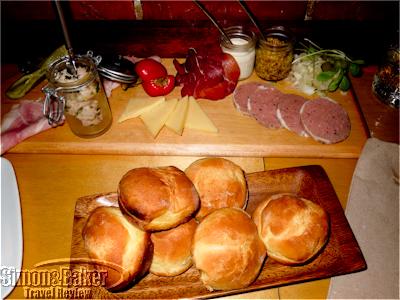
A second variation on the special board of the day
Once again our order was worthwhile. The fries, cooked in duck fat and served on a stand, were as good as the first time and stayed hot until the end. The fries were prepared with seasoned salt and served with our choice from among eight dipping sauces. The House Cured Ham and Cheese grilled sandwich and cold deli board were both rewarding.
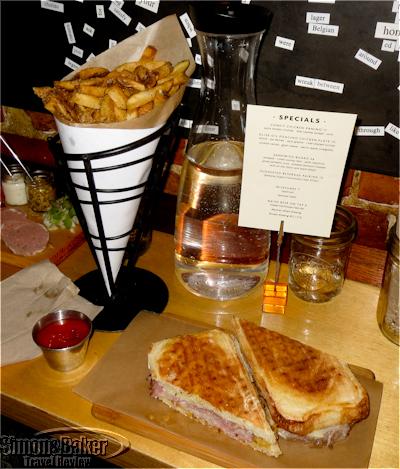
The grilled sandwich and fries with truffle ketchup
The well made flavorful dishes prepared with many local ingredients (a list of suppliers appeared on the restaurant website) more than made up for the crowded and loud ambiance and uneven service. We also liked that Duckfat, according to its website, is independent and locally owned. Should we return to Portland, Duckfat will be at the top of our eatery list.
Fighting for elephants Chiawa Camp developed colorful past
By Laura Scheiber
Photos by Matthew Harris
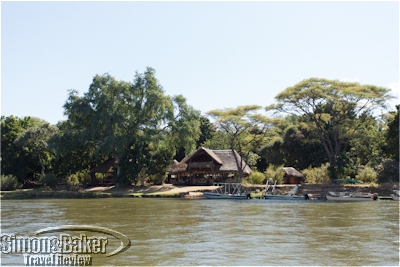
Chiawa Camp
My husband and I had high hopes that Chiawa Camp, a tented property in Zambia‘s Lower Zambezi region, would provide us a premiere safari experience based on the property’s awards and recognition. Soon after our arrival we discovered the camp, situated on a picturesque riverbank in the Lower Zambezi National Park, offered outstanding game viewing, luxury camp accommodations, and excellent cuisine and service. We also learned that Chiawa had another side. Its founders, Dave and Grant Cumings, a father and son team, participated in the fight against poaching. While staying at the camp, we had a chance to chat with Grant about how it all began.
Back in the day, Dave used to take his son Grant on bush trips, exploring east along the Zambezi River. Eventually they arrived at Chiawa’s current location and found themselves going back for repeat trips. Sleeping under the stars and surrounded by amazing wildlife and geography, they believed the spot to be a magical place, and wanted to share it with others. They started taking friends and family on trips to the area. In time, the practice evolved into photo safaris with diplomats living in Lusaka. Through some convincing and lucky contacts, the governmental parks department awarded Dave and Grant a permit to build a semi permanent camp in the Park.
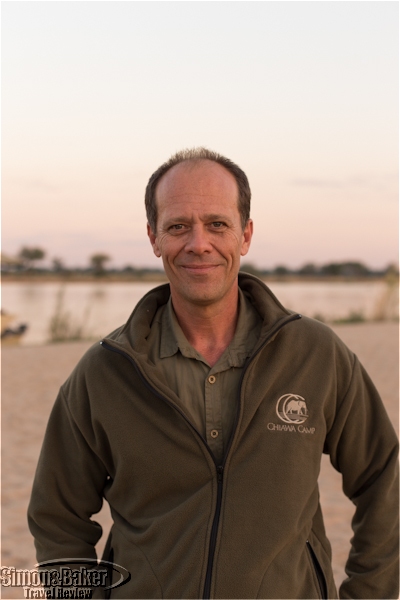
Grant Cumings, co-owner, Chiawa Camp
At first things were difficult. Zimbabwe is just on the other side of the river, and the civil war saw a lot of guerrilla activity in the region long before Chiawa’s existence. Soldiers from both sides would frequently fight on the Zambian side of the river. Eventually the conflict ceased, leaving a number of former soldiers in possession of firearms. With few opportunities to earn an income, many turned to poaching. Grant spoke poignantly of seeing his first butchered elephant as a young man, something that moved him deeply and motivated him to fight passionately for conservation.
The Cumings father and son team started to move against poachers, working with scouts to track, capture and turn them over to the authorities. It was dangerous work. To their dismay they uncovered evidence of corruption, which strongly suggested that some officials were in collusion with the poachers. On one occasion, Dave brought in a detective from Lusaka to break the poaching ring. A number of poachers were found and captured, and used rifle shells were gathered as hard evidence of poaching activity. However, the day after capture a detective said the shells had mysteriously been misplaced.
It quickly became apparent to them that the poachers had bought him off. Dave thought quickly on his feet, and in a moment of inspiration, responded that losing the shells was no problem since he had some extras (which wasn’t true). That tricked the detective into thinking that the prosecution would go ahead. During a tense showdown, the detective “found” the missing shells and the prosecution was able to proceed.
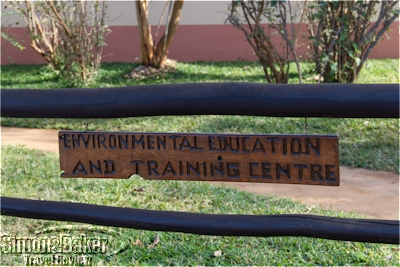
The Conservation Lower Zambezi Environmental Education Program
At the height of poaching, Grant and his team might come across 60 to 70 mutilated elephants each year, whereas now they might come across six to seven carcasses in the bush, most of them from animals that had died of natural causes. Grant and his father realized that capturing poachers was only half the story, education was also key. If poachers and the children of poachers could be made to understand that keeping those beautiful animals alive was worth more in the long run than killing them, then conservation efforts would be sustainable.
Through a serendipitous meeting with a Danish ambassador who drove into Chiawa Camp one day, Grant was able to secure Danish sponsorship and establish the Conservation Lower Zambezi Environmental Education Program.
A residential center, he explained, it strives to provide a wide variety of conservation and HIV/AIDS education to Zambians from all over the country. It also hosts the rigorous guide certification exams. The program, he said, has provided career opportunities for many locals, some of whom now work as guides at Chiawa. Grant explained that although poaching remains an ongoing battle to this day, it has significantly declined in the region thanks to the efforts of the Cumings family members and park scouts, and subsequently through Conservation Lower Zambezi, a charity they co-founded and of which Grant is a trustee and past chairman.
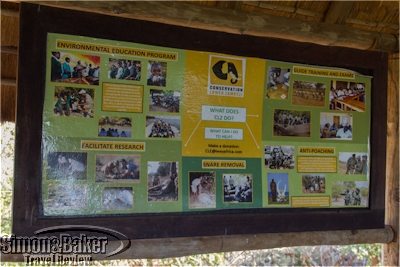
A bulletin board at the Conservation Lower Zambezi facilities
Grant’s conservation efforts are not yet done. His dream is that one day the black rhino might be introduced back into the Lower Zambezi National Park. He’s resigned to the fact that this isn’t possible just yet because they would present too tempting a target for the poachers. His hope is that over time this will change, through continued education and anti-poaching efforts.
It was a pleasure to meet Grant, an inspirational pioneer of conversation in the Lower Zambezi region. While we thoroughly enjoyed our luxury safari experience at Chiawa, what made it special was understanding firsthand the ethos of conservation that is so intricately intertwined in the history and current practices of the camp. We hope to one day return and see its continued conservation efforts evolve to preserve the natural beauty of the Lower Zambezi National Park.
Maine Moosehead Lake fall flight aboard rare seaplane feast for the eyes
By Elena del Valle
Photos by Gary Cox

Currier’s Flying Service had a selection of amphibious aircraft
During a stay in the Moosehead Lake area in Maine we took advantage of the autumn picture perfect weather by going on a scenic flight. The Moosehead & Lobster Lake Air Tour offered by Currier’s Flying Service, Inc. consisted of an hour long scenic flight on a 1954 de Havilland Beaver seaplane, one of few such seaplanes still in commercial use in the United States. A two person minimum was necessary.
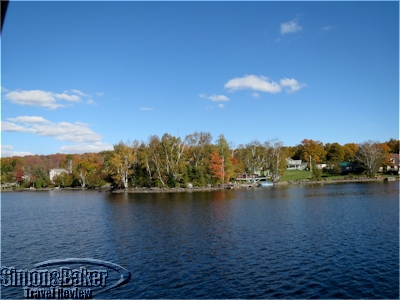
The shore of Moosehead Lake before takeoff
We departed from just outside of Greenville on the southern side of the lake, flying north along the Moosehead Lake’s eastern shore toward Lobster Lake then west past Mount Kineo and south again to our point of departure. In addition to our pilot, we shared the plane with a couple celebrating their wedding anniversary.
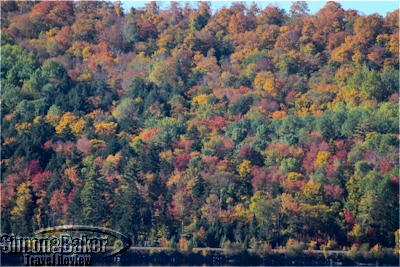
Fall colors from the air
Fall colors were beginning to spread along the canopy of tress across the lake area like a blossoming palette of colors on a painter’s canvas. The sun was reflected brightly on the water during our mid afternoon flight.
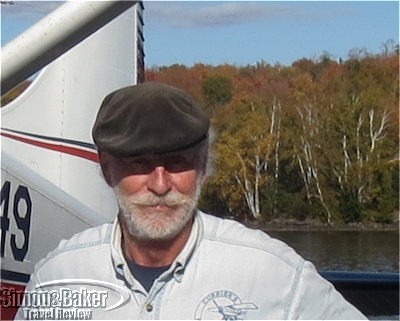
Roger Currier, pilot and co-owner of Currier’s Flying Service
As we flew north we could see the small shadow our plane cast along our path. The time on the plane remains among my vivid memories of that trip. Should I return to that part of Maine I would take the tour again in a heartbeat.
A modern safari experience at Chinzombo camp, Zambia
By Laura Scheiber and Matthew Harris
Photos by Matthew Harris
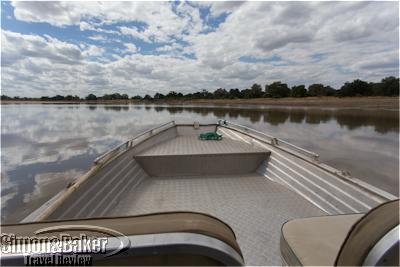
Crossing the Luangwa River
We arrived at the bank of the Luangwa River, at the end of a game viewing drive in Zambia’s South Luangwa National Park from our previous safari lodge. After loading our luggage into a small boat, we were ferried across the river by one of our hosts, Finlay Hunter. On our arrival at Chinzombo, a luxury safari camp, Finlay and his wife and cohost, Wendy offered us cool washcloths to freshen up, served us fruit cocktail drinks and made us feel at home. It was a sign of things to come. The young, energetic, professional and attentive couple went out of their way to ensure our stay was perfect.
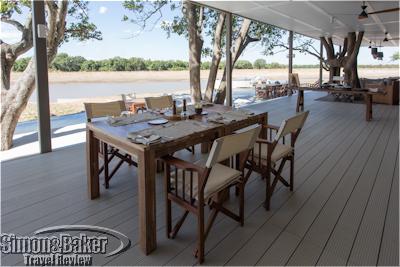
View of the Luangwa River from the dining area of Chinzombo camp
The camp, on the Luangwa riverbank opposite the beautiful South Luangwa National Park, is a one hour drive from Mufwe Airport, which is a quick hour flight to Lusaka. Being close to the national park meant that we were able to enjoy great game viewing drives and walks with our charismatic guide Shaddy Nkoma. With years of guiding experience, he provided fascinating insight into the African bush. He also regaled us with stories of his youth in Zambia including having to swim to school through crocodile infested rivers. One time he even lost his clothes in the process.
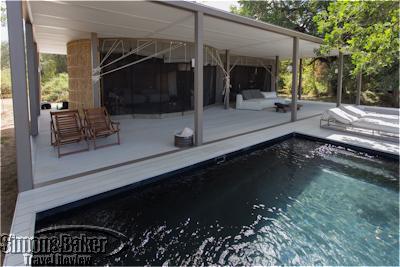
Our room with a pool view
The newly opened camp was a joy for us as guests. The architecture was modern with a nod to safari camps of old, with leather, wood and brass fittings. The handsome open bar and dining area also had a section of paraphernalia from the late Norman Carr, a safari industry veteran. In it were some wonderful prints of him with two male lions he raised from cubs.
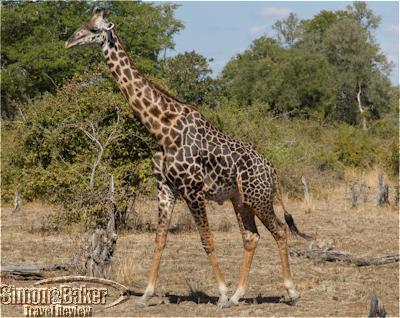
A giraffe we saw on a drive from Chinzombo camp
Our open fronted luxury tented accommodations with a personal plunge pool and views out onto the Luangwa River were superb. Amenities that made us feel pampered included bathrobes, slippers, hot water bottles the staff placed in our bed during the evening room service, and complimentary drinks in the fridge.

River viewing from the couch
The cuisine at the camp was delicious, fresh and plentiful. We especially enjoyed the sundowners and cakes served on safari drives. It was a wonderful way to watch the sunset. Chinzombo had the feel of a modern luxury boutique hotel with safari influences and access to the amazing African bush at its doorstep. We thoroughly enjoyed our contemporary safari experience.
Portland shop for delicious fresh from scratch baked goods without artificial ingredients
By Elena del Valle
Photos by Gary Cox
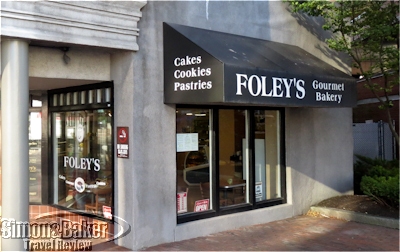
Foley’s Bakery is on the ground floor of an office building
On a crisp, cool fall morning in Portland, Maine we found Foley’s Cakes (Foley’s Cakes, 1 Monument Way, Portland, Maine 04101, + 207-773-CAKE (2253), http://foleyscakes.com), a small bakery and cake shop on the ground floor of an office building in the heart of the city. It was an easy walk from our accommodations. What drew us back regularly in a city with a high ratio of bakeries was the warm welcome from its owners and some treats that quickly became favorites such as the buttery and flaky ham and cheese croissants.

The reverse chocolate chip cookie was a favorite
We also became fans of the extra large cookies. We sampled the chocolate cookies with white chocolate chunks and the peanut butter cookies first. We loved the shop’s wholesome flavors and were especially pleased to discover everything they sold was made fresh from scratch on the premises without any artificial ingredients or preservatives. Increasingly we encounter stores and bakeries that sell products previously frozen or made or premade by someone else. Finding a bakery that sold only fresh products made onsite such as theirs was a pleasure.
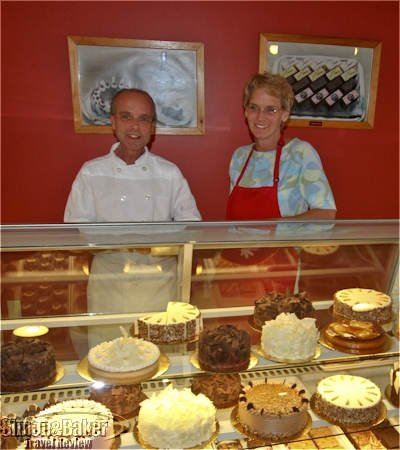
Ed and Molly Foley in front of one of the display cases
Pastry chef Ed Foley and his wife Molly were the owners of Foley’s Cakes, a European-style bakery established in 2011. Previous to that they had owned the original Foley’s Bakery also in central Portland from 1997 to 2002. He made all the well presented and appetizing baked goods sold at the shop facing Monument Square.
In a corner on the right side of the shop, there was a refrigerator with cold beverages and next to it a self service hot beverages section. As we sat at one of a half a dozen tables drinking coffee and tea and munching of croissants and cookies, we watched a steady flow of regular customers stream by, many buying baked goods to go. Molly greeted most by name. She seemed to know effortlessly what everyone’s favorites were from the child celebrating her birthday to the business executive with guests. By our second visit she remembered my preference for the white chocolate chunk cookies and my travel partner’s preference for the peanut butter ones.
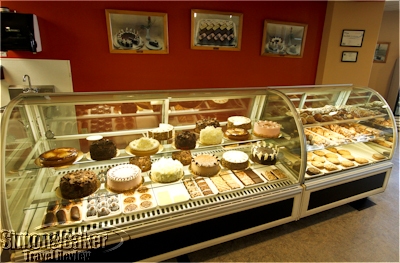
The tempting display of pastries
On display in two large cases there was a line of pastries, cookies, and cakes made on site. We could see the racks and baking equipment behind the cash register on the left side of the open room. Wedding cakes were also available according to the shop’s website.
“The fact that all of the baked goods are made from scratch plus the baked goods we offer are unique to Foley’s,” Molly said when asked what makes their shop special.
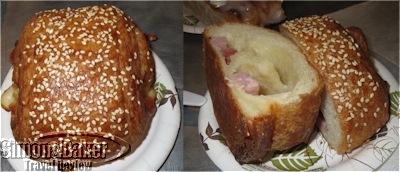
The ham and cheese croissant was a favorite
Chef Foley, with 20 years of experience, trained with European pastry chefs in the United States. Prior to opening his own shop he worked at The Grand Hotel, Mackinac Island, Michigan; Gasparilla Inn & Cottages, Boca Grande, Florida; The Tivoli Restaurant and Pastry Shop, Rosslyn, Virginia; and The Watergate Pastry Shop, Washington, D.C.; and was an instructor at the New England Culinary Institute, Montpelier, Vermont.
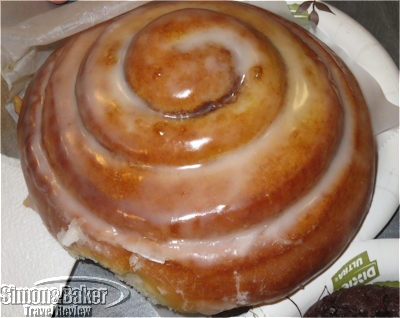
The cinnamon swirl
There were so many tempting cakes and pastries in the shop I left without sampling I’m hoping for a second visit to Maine’s largest city. For example, Foley’s best selling cake is the Marble Mousse Cake. It is made of two thin layers of chocolate cake with a thick layer of chocolate mousse, a thick layer of white chocolate mousse and a thin layer of pound cake covered in chocolate ganache.








